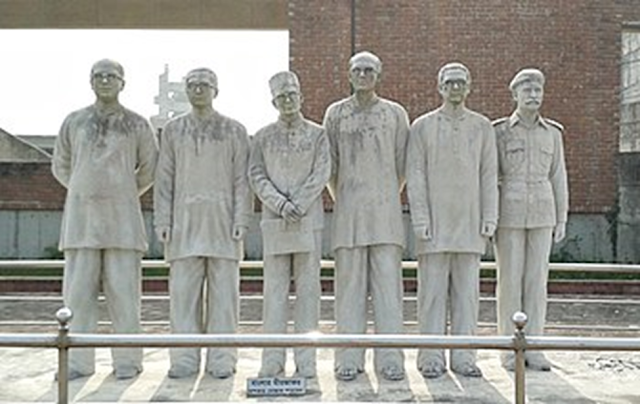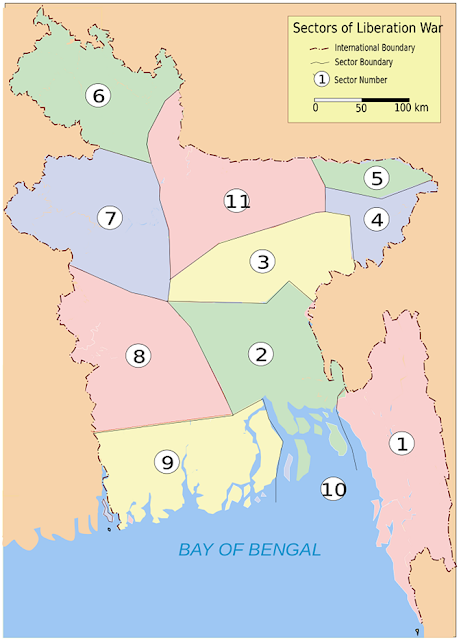Mujibnagar Government the government constituted at Mujibnagar to conduct the Bangladesh war of liberation, formed on 10 April 1971 after the declaration of independence on 26 March 1971. The Mujibnagar government headed by tajuddin ahmad took oath on 17 April 1971 at Mujibnagar. This government had also been known as Mujibnagar Government in-exile, as the activities of the government had been conducted from outside of the territory of Bangladesh.
Background
The Awami League won by the
absolute majority in the general election of Pakistan in 1970 under the
leadership of Bangabandhu Sheikh Mujibur Rahman. The people of East Pakistan
voted for the Awami League to be free from the oppression of the Pakistani
rulers. But the rulers of the West Pakistan started hatching plots not to hand
over the power to the Awami League. The then Pakistan President and the
Military Chief Mohammad Yahia Khan suspended the session of the national
assembly on 1 March 1971 sine die. Sheikh Mujibur Rahman called for Ashhojog
Andolon on 2 March protesting the decision. In a historic speech delivered at
the Racecourse on 7 March 1971, Bangabandhu called for a decisive struggle to
achieve the liberation and independence. The Pakistan army swooped on the
civilians on 25 March. Bangabandhu declared the independence on the early hours
of 26 March. The formal campaign of the liberation war began after the
formation of the Mujibnagar government and the approval of the constitutional
declaration on 10 April.
Mujibnagar Government
The first official government of
the People's Republic of Bangladesh, popularly known as the Mujibnagar
Government, was formed on April 10, 1971.
The newly formed government took
oath on 17th April, 1971 in the then Meherpur district.
The venue of the oath was a mango
forest in Baidyantala which was renamed by the provisional government.
Why Mujibnagar Government
was formed?
- To ensure the equality, human dignity and social justice for the people of Bangladesh.
- To organize the civil administration.
- To keep the unity of the general people irrespective of classes or professions including Armed Forces, Police & EPR.
- To organize the freedom fighters.
- To arrange the training of freedom fighters.
- To keep the freedom fighter’s morale high.
Formation of Mujibnagar
Government
The formation of the Mujibnagar
Government was very important in the history of liberation.
Tajuddin Ahmed played a
significant role.
On 1st April, 1971, he and
Barrister Amirul Islam went to India and on 3rd April, he met the then Indian
Prime Minister Indira Gandhi. He explained the overall situation that was
prevailing in Bangladesh.
On 17th April, 1971, Syed Nazrul
Islam hoisted the National flag in absence of Bangabandhu Sheikh Mujibur Rahman.
Professor Md. Yusuf Ali read out the announcement of independent Bangladesh at
the oath taking ceremony.
Some local singers sang the
National Anthem "Amar sonar Bangla, ami tomay valobashi". The oath
taking program was witnessed by a 10,000 strong crowd which included
contingents of the EPR, Ansar and Freedom fighters. A press statement was
issued after the inauguration of the government.
Panel of Mujibnagar Government
President: Bangabandhu Sheikh Mujibur Rahman
Vice President: Syed Nazrul Islam
(Acting President in absence of Bangabandhu)
Prime Minister: Tajuddin Ahmed
Finance Minister: M. Mansur Ali
Home, Relief and Rehabilitation
Minister: A.H.M. Qamaruzzaman
Foreign and Law Minister: Khondoker
Mostaq Ahmed
Commander-in-Chief: Colonel
Muhammad Ataul Gani Osmani
Other Members
Major General Abdur Rab: Chief of
Staff
Abdul Mannan: Chief of the
Department of Press, Information, Radio and Film
Yusuf Ali: Chief of the
Department of Relief and Rehabilitation
Matiur Rahman: Chief of the
Department of Commerce
Amirul Islam: Chief of the
Volunteer Corps
Advisory Committee
An advisory committee of 6
members was formed to provide necessary suggestions and guidance to the
government of Independent Bangladesh.
- Maolana Abdul Hamid Khan Bhashani
- Professor Mozaffer Ahmed
- Comrade Moni Singh
- Sri Monoronjon Dhar
- Tajuddin Ahmed &
- Khondoker Mostaq Ahmed were on the committee.
Activities of Mujibnagar
Government
The government ran the
administration by the Bangalee officials. There were 12 ministries or divisions
in it. Those were the Ministry of Foreign affairs; the Ministry of Finance, the
Ministry of Industry and Commerce; the Cabinet Secretariat; the General
Administration; the Health and Welfare Division; the Relief and Rehabilitation
Division; the Engineering Division; the Planning Commission; the Controlling
Board for Youth and Reception Camp etc.
The Mujibnagar government
established Bangladesh mission in various important cities (Calcutta, Delhi,
London, Washington, New York) of the world. These missions campaigned for
having support in favour of Bangladesh from the world community.
The government appointed Justice
Abu Sayed Chowdhury as a special envoy. He tried his best to get support of
world leaders and the public as well in favour of the Liberation War.
The government divided the
country into 11 sectors. Besides, some sub-sectors and 3 Brigade forces were
formed.
The provisional president and the
Prime Minister would keep the whole country motivated through their speeches
over the radio.
Mujibnagar government contacted
the United Nations, European countries, the USA, Russia and other powerful
nations to mobilize public opinion in favor of the Mujibnagar government to get
international recognition and support.
Under the leadership of
Mujibnagar government, the freedom fighters fought in the battle fields to
liberate the country from the occupation of the Pakistani forces. Many of them
sacrificed their lives for the cause of the mother land.


